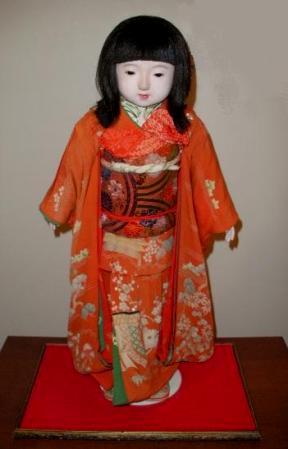Number 45
|
|
As he unwrapped the doll, he found the leg joints were not working properly so he took apart a few stitches and was able to replace the loose screws. In this state of undress, he proceeded to photograph the doll because he knew that the label on the back was so important in validating the authenticity of his find. Sure enough the label read “The Tokyo Doll Wholesale Traders’ Association,” and it also showed the name of the artist. Through diligent research, he was able to determine his doll’s kimono had the same design of Miss Nara although the color was in shades of orange instead of purple. This interesting design is a scattering of maple leaves with numerous parallel white lines representing mist. It also had multicolored waving banners called kichou. The lower part of the kimono has colored pine trees, cloud outlines, light colored daisies, and blue balloon flowers with assorted shaped green and blue leaves. The growth pleat has a gold covered gate made of rice straw with more pine trees and a profusion of cherry blossoms. The lower edge of the kimono front has several chrysanthemums with wavy flowing water lines near the hemline. Redressing the doll properly was a challenge—especially the twelve-foot long musubime (bow) of the obi. Once he had put the clothing back together, he shared some wonderful pictures with me of his treasure. Although the doll has a minor crack by the right ear (a common problem since the heads were originally made in two sections) and some cracking of gofun on the limbs, his doll looks beautiful considering she is 82 years old having been sent to the Untied States in 1927. Unfortunately, the right sleeve has frayed on the top crease line, but other than that she is in great condition. Her demure smile and shining eyes seem to indicate she is hiding a secret of her time in America. The five crests were determined to be a variation of the cherry blossom (sakura). He now has his doll (whose original name is still unknown) in a glass case to protect her from the elements. It is known the doll is from one of the 47 prefectures of Japan because both of her hands are in an open position, which is contrary to the dolls from the cities that have the right hand closed into a fist position. With assistance from a well-known researcher in Japan, Michiko Takaoka, he hopes to soon learn to call his doll by her correct name. What an exciting find this has been! It should be noted this is the first Friendship Doll found outside of the USA. Could some of the 13 missing dolls (of the original 58) be across the sea? It has taken twenty years of dedicated research by several Japanese doll lovers to find 45 of these lost treasures whose story of friendship between Japanese and American children is so touching. May 2009 |
